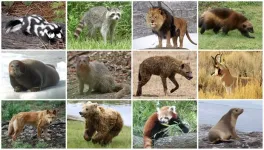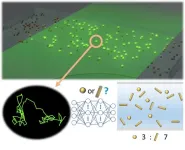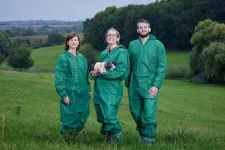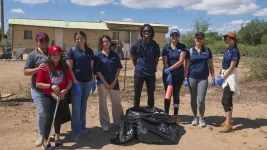(Press-News.org) Since the HMS Beagle arrived in the Galapagos with Charles Darwin to meet a fateful family of finches, ecologists have struggled to understand a particularly perplexing question: Why is there a ridiculous abundance of species some places on earth and a scarcity in others? What factors, exactly, drive animal diversity?
With access to a mammoth set of global-scale climate data and a novel strategy, a team from the Department of Watershed Sciences in Quinney College of Natural Resources and the Ecology Center identified several factors to help answer this fundamental ecological question. They discovered that what an animal eats (and how that interacts with climate) shapes Earth’s diversity.
The work was recently published in the high-impact journal Ecology Letters.
“Historically studies looking at the distribution of species across Earth's latitudinal gradient have overlooked the role of trophic ecology — how what animals eat impacts where they are found,” said Trisha Atwood, author on the study from the Department of Watershed Sciences and the Ecology Center. “This new work shows that predators, omnivores and herbivores are not randomly scattered across the globe. There are patterns to where we find these groups of animals.”
Certain locations have an unexpected abundance of meat-eating predators — parts of Africa, Europe and Greenland. Herbivores are common in cooler areas, and omnivores tend to be more dominant in warm places. Two key factors emerged as crucial in shaping these patterns: precipitation and plant growth.
Precipitation patterns across time play a big role in determining where different groups of mammals thrive, Atwood said. Geographical areas where precipitation varies by season, without being too extreme, had the highest levels of mammal diversity.
“Keep in mind that we aren’t talking about the total amount of rain," said Jaron Adkins, lead author on the research. “If you imagine ecosystems around the world on a scale of precipitation and season, certain places in Utah and the Amazon rainforest fall on one end with low variability — they have steady levels of precipitation throughout the year. Other regions, like southern California, have really high variability, getting about 75 percent of the annual precipitation between December and March.”
But the sweet spot for predators and herbivores fell in a middle zone between the two extremes, he said. Places like Madagascar, where precipitation patterns had an equal split between a wet season and a dry one (six months each), had the ideal ecological cocktail for promoting conditions for these two groups. Omnivore diversity tends to thrive in places with very stable climates.
The second important factor connected with mammal diversity the work uncovered was a measure of the amount of plant growth in an area, measured as “gross primary productivity.”
“It makes intuitive sense for plant-eating animals to benefit from plant growth,” Adkins said.
But this measure actually impacted carnivores most, according to the research. The strong relationship between predators and plant growth highlights the importance of an abundance of plants on an entire food chain's structural integrity.
“It was surprising that this factor was more important for predators than omnivores and herbivores,” Atwood said. “Why this is remains a mystery.”
Although evolutionary processes are ultimately responsible for spurring differences in species, climate conditions can impact related factors — rates of evolutionary change, extinction and animal dispersal — influencing species and trait-based richness, according to the research.
Animal diversity is rapidly declining in many ecosystems around the world through habitat loss and climate change. This has negative consequences for ecosystems. Forecasting how climate change will disrupt animal systems going forward is extremely important, Atwood said, and this research is a first step in better managing future conditions for animals around the world.
“Animal diversity can act as an alarm system for the stability of ecosystems,” Atwood said. “Identifying the ecological mechanisms that help drive richness patterns provides insight for better managing and predicting how diversity could change under future climates.”
In addition to Adkins and Atwood, the research included seven authors currently or previously associated with the Department of Watershed Sciences and the Ecology Center: Edd Hammill, Umarfarooq Abdulwahab, John Draper, Marshall Wolf, Catherine McClure, Adrián González Ortiz and Emily Chavez.
END
Raining cats and dogs: research finds global precipitation patterns a driver for animal diversity
2023-10-24
ELSE PRESS RELEASES FROM THIS DATE:
SDMPH welcomes Charles Parks Richardson, MD
2023-10-24
Charles Parks Richardson, MD, has been elected as a Board Member of the Society for Disaster Medicine and Public Health.
Dr. Richardson is an American physician who is both an accomplished physician and a medical innovator. He has not only been the inventor of several medical devices and pharmaceutical processes but has translated these into successful business ventures in partnership with such prestigious organizations as the American Heart Association.
He is currently the CEO of Critical Medical Infrastructure (CMI), KRS Global Biotechnology, and GeneRx, ...
Deep learning solves long-standing challenges in identification of nanoparticle shape
2023-10-24
Innovation Center of NanoMedicine (iCONM; Center Director: Kazunori Kataoka; Location: Kawasaki, Japan) has announced with The University of Tokyo that a group led by Prof. Takanori Ichiki, Research Director of iCONM (Professor, Department of Materials Engineering, Graduate School of Engineering, The University of Tokyo), proposed a new property evaluation method of nanoparticles’ shape anisotropy that solves long-standing issues in nanoparticle evaluation that date back to Einstein's time. The paper, titled " Analysis of Brownian motion trajectories of non-spherical nanoparticles ...
Large, real-world study compares modern treatment options for pulmonary embolism (REAL.PE)
2023-10-24
SAN FRANCISCO – A large, modern real-world analysis published today in the Journal of the Society for Cardiovascular Angiography & Interventions (JSCAI), provides vital insights into the safety of novel therapies including ultrasound-assisted catheter-directed thrombolysis (USCDT) and mechanical thrombectomy (MT) that have been developed to address the increased morbidity and mortality of elevated risk pulmonary embolism (PE). Findings were presented today at TCT 2023.
Pulmonary embolism is a potentially life-threatening condition where a blood clot embolizes to the lungs, obstructing ...
NSF FABRIC project announces groundbreaking high-speed network infrastructure expansion
2023-10-24
The NSF-funded FABRIC project has completed installation of a unique network infrastructure connection, called the TeraCore—a ring spanning the continental U.S.—which boasts data transmission speeds of 1.2 Terabits per second (Tbps), or one trillion bits per second. FABRIC previously established preeminence with its cross-continental infrastructure, but the project has now hit another milestone as the only testbed capable of transmitting data at these speeds—the highest being twelve times faster than what was available ...
More animal welfare or more environmental protection?
2023-10-24
Which sustainability goals do people in Germany find more important: Animal welfare? Or environmental protection? Human health is another one of these competing sustainability goals. A team of researchers from the Department of Agricultural and Food Market Research at the University of Bonn have now found that consumers surveyed in their study would rather pay more for salami with an “antibiotic-free” label than for salami with an “open barn” label that indicates that the product promotes animal welfare. The results have now been published in the journal “Q Open.”
The animal husbandry sector ...
Mass General Brigham names Paul Anderson Chief Academic Officer
2023-10-24
Following a national search, Paul Anderson, MD, PhD, has been named Chief Academic Officer for Mass General Brigham. Anderson, who has been serving in this role on an interim basis since January 1, oversees Mass General Brigham’s world-class research and teaching enterprise, which includes two academic medical centers — Mass General Hospital and Brigham and Women’s Hospital — and three specialty hospitals. Mass General Brigham is the largest hospital system-based research enterprise in the nation, with an annual ...
Biological fingerprints in soil show where diamond-containing ore is buried
2023-10-24
Researchers have identified buried kimberlite, the rocky home of diamonds, by testing the DNA of microbes in the surface soil.
These ‘biological fingerprints’ can reveal what minerals are buried tens of metres below the earth’s surface without having to drill. The researchers believe it is the first use of modern DNA sequencing of microbial communities in the search for buried minerals.
The research published this week in Nature Communications Earth and Environment represents a new tool for mineral exploration, where a full toolbox could save prospectors time and a lot of money, says co-author Bianca Iulianella Phillips, a doctoral candidate at ...
Adding crushed rock to farmland pulls carbon out of the air
2023-10-24
Adding crushed volcanic rock to cropland could play a key role in removing carbon from the air. In a field study, scientists at the University of California, Davis, and Cornell University found the technology stored carbon in the soil even during an extreme drought in California. The study was published in the journal Environmental Research Communications.
Rain captures carbon dioxide from the air as it falls and reacts with volcanic rock to lock up carbon. The process, called rock weathering, can take millions of years ...
Neuroscientist Huda Akil, Ph.D., wins National Medal of Science
2023-10-24
She has explored the brain’s secrets for more than 50 years, delving deep into the genes, proteins and cells that help govern our emotions and moods, and our responses to pleasure and pain.
And today, Huda Akil, Ph.D., received the nation’s highest scientific honor – the National Medal of Science -- for those contributions and their impact on humankind’s understanding of depression, anxiety, addiction and more.
Akil, a neuroscientist at the University of Michigan Medical School and Michigan Neuroscience Institute, and her fellow awardees were honored at the White House in a ceremony ...
AZ-HOPE receives $3.2M HRSA grant to support future health care professionals
2023-10-24
Arizona Health Opportunities Pathways to Excellence, a program of the University of Arizona Health Sciences Office of Equity, Diversity and Inclusion, received a $3.2 million grant from the U.S. Department of Health and Human Services to help students from disadvantaged backgrounds achieve their dreams of becoming health care professionals.
Arizona Health Opportunities Pathways to Excellence, or AZ-HOPE, is a collaboration between academic and community partners to support students’ educational endeavors and help them overcome barriers on the pathway ...






